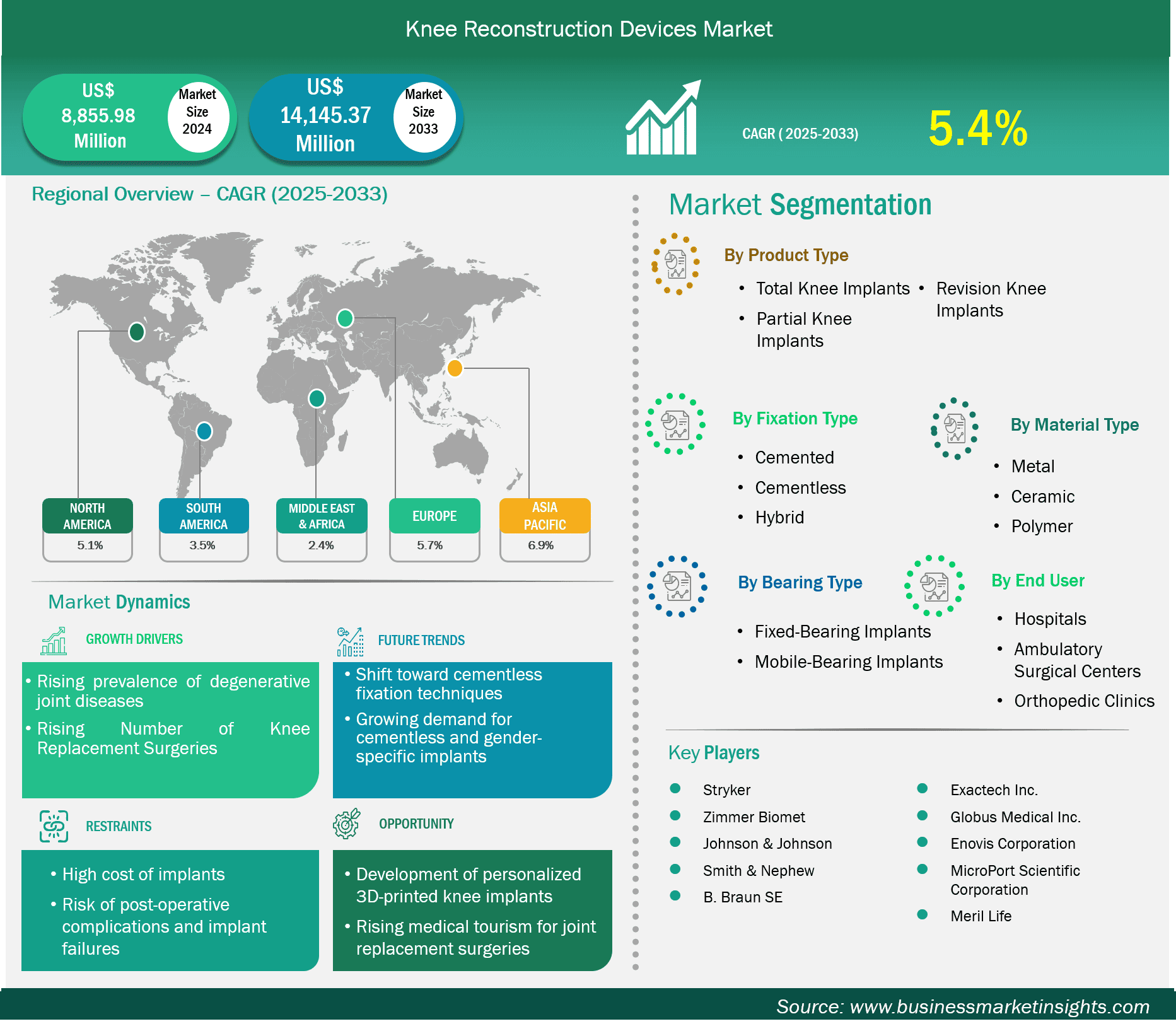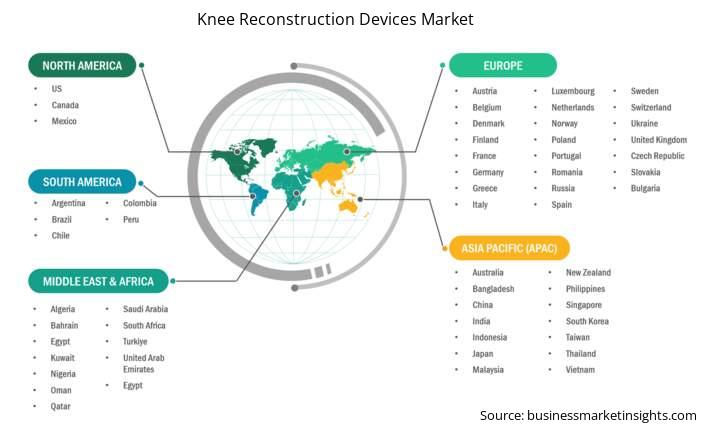Knee Reconstruction Devices Market Outlook (2022-2033)
No. of Pages: 200 | Report Code: BMIPUB00031759 | Category: Life Sciences
No. of Pages: 200 | Report Code: BMIPUB00031759 | Category: Life Sciences
The knee reconstruction devices market size is expected to reach US$ 14,145.37 million by 2033 from US$ 8,855.98 million in 2024. The market is estimated to record a CAGR of 5.4% from 2025 to 2033.
The knee replacement device market is growing steadily with rising cases of osteoarthritis, an ageing population, and advances in surgical techniques such as minimally invasive and robotic surgery. Total knee replacement remains the most common procedure and has a major market share, followed by increasing demand for partial and revision implants. Recent technological advancements in implant materials and design are enhancing clinical success and patient satisfaction.
In line with the adoption rate, the global knee reconstruction devices market stood at US$ 8,855.98 million in 2024 and is expected to reach US$ 14,145.37 million by 2033.Fast adoption is occurring in developing markets, especially the Asia-Pacific and Latin America regions, due to increased healthcare infrastructure and growing awareness. Leading players are focusing on strategic alliances, product innovation, and electronic surgery solutions to enhance market position and address evolving needs of surgeons and patients alike.

Key segments that contributed to the derivation of the knee reconstruction devices market analysis are product type, fixation type, material type, bearing type and end user.
Rising prevalence of degenerative joint diseases such as osteoarthritis is a major driving factor for this market. Such diseases cause progressive cartilage degeneration within the knee joint, resulting in pain, swelling, stiffness, and limited mobility. As the condition advances, normal activities such as walking or going up stairs become challenging, and people are forced to look for surgical intervention. Although medication, exercise, and physiotherapy can treat earlier stages, advanced conditions necessitate joint replacement. Sedentary lifestyle, obesity, and repetitive physical stress are among the factors that have led to an increase in the number of affected individuals. Sports injuries and joint trauma also speed up the degeneration of joints even in the youth. With the increasing burden of joint diseases across all age groups, healthcare systems are witnessing increased demand for knee replacement procedures. Increasing demand is spurring the development of Better implants and innovative surgical solutions, thus driving the market ahead.
The rising number of knee replacement surgeries drives demand for knee replacements surgeries for knee such as knee and hips. These are the most common orthopedic procedures performed globally. Surgical technique improvements combined with superior implant materials and expanded insurance coverage have increased both the effectiveness and accessibility of these surgeries.
For instance, according to the report published in September 2024 by American Association of Hip and Knee Surgeons (AAHKS), the total number of hip replacement procedures in U.S. were 763,691 in 2022 which increased to 793,082 in 2023, marking a 3.8% growth. Similarly, knee surgeries experienced an even stronger upward trend, with the total number increasing from 1,293,438 in 2022 to 1,359,110 in 2023, a 5.1% jump.
The increasing number of surgical operations generates high demand for knee reconstruction devices needed in both initial surgeries and subsequent procedures. The knee reconstruction devices market experiences substantial growth due to the rising frequency of knee replacement surgeries.
By product type, the knee reconstruction devices market is segmented into total knee implants, partial knee implants and revision knee implants. The total knee implants segment dominated the market in 2024. Total knee implants are the dominant product type because most knee arthroplasty procedures are for end-stage osteoarthritis, where full joint replacement is required. They provide comprehensive pain relief, stability, and function. Partial knee replacements are used only in selective cases, whereas total knee arthroplasty (TKA) is the standard of care worldwide.
By fixation type, the knee reconstruction devices market is segmented into cemented, cementless, and hybrid. The cemented segment dominated the market in 2024. Cemented fixation dominates due to its proven long-term success, especially in elderly patients with poor bone quality. It ensures immediate stability, faster post-operative recovery, and lower revision rates compared to uncemented methods.
By material type, the market is segmented into metal, ceramic and polymer. The metal segment held the largest share of the market in 2024. Metal leads as the preferred material due to its superior strength, biocompatibility, durability, and load-bearing capacity, which are essential for long-term performance in knee implants, particularly in weight-bearing knees like the hip and knee.
by bearing type, the market is segmented into fixed-bearing implants and mobile-bearing implants. The fixed-bearing implants segment held the largest share of the market in 2024. Fixed-bearing implants are more common because they are cheaper, easier for doctors to use, work well over time, and are suitable for most patients needing knee replacement surgery.
By end user, the market is segmented into hospitals, ambulatory surgical centers, and orthopedic clinics. The hospitals segment held the largest share of the market in 2024.Hospitals dominate due to advanced surgical infrastructure, availability of skilled orthopedic surgeons, and higher patient footfall for complex knee procedures, enabling efficient handling of large volumes of knee reconstruction surgeries.
| Report Attribute | Details |
|---|---|
| Market size in 2024 | US$ 8,855.98 Million |
| Market Size by 2033 | US$ 14,145.37 Million |
| Global CAGR (2025 - 2033) | 5.4% |
| Historical Data | 2022-2023 |
| Forecast period | 2025-2033 |
| Segments Covered |
By Product Type
|
| Regions and Countries Covered | North America
|
| Market leaders and key company profiles |
|
The "Knee Reconstruction Devices Market Size and Forecast (2022–2033)" report provides a detailed analysis of the market covering below areas:

The geographical scope of the knee reconstruction devices market report is divided into five regions: North America, Asia Pacific, Europe, Middle East & Africa, and South & Central America. The knee reconstruction devices market in Asia Pacific is expected to grow significantly during the forecast period.
The Asia Pacific knee reconstruction devices market is segmented into China, Japan, South Korea, India, Australia, New Zealand, Indonesia, Malaysia, Philippines, Singapore, Thailand, Vietnam, Taiwan, Bangladesh and Rest of Asia. The Asia Pacific knee replacement devices market is witnessing robust growth, driven by increasing healthcare investments, a rising elderly population, and growing awareness of joint replacement procedures. These nations include China, India, Japan, South Korea, and Australia, which are driving the region with increasing access to sophisticated orthopedic treatment. Enhancing health infrastructure and a boom in lifestyle-related joint disorders are accelerating procedure Moreover, the use of minimally invasive and robot-assisted surgery is slowly expanding throughout urban centers. Although cost sensitivity and unequal access in rural zones continue to be issues, positive government policies and the development of medical tourism are driving significant Global and regional players are actively increasing their presence with partnerships, product releases, and localization strategies to capitalize on this high-potential market.
The knee reconstruction devices market is evaluated by gathering qualitative and quantitative data post primary and secondary research, which includes important corporate publications, association data, and databases. A few of the key developments in the knee reconstruction devices market are:
The Knee Reconstruction Devices Market is valued at US$ 8,855.98 Million in 2024, it is projected to reach US$ 14,145.37 Million by 2033.
As per our report Knee Reconstruction Devices Market, the market size is valued at US$ 8,855.98 Million in 2024, projecting it to reach US$ 14,145.37 Million by 2033. This translates to a CAGR of approximately 5.4% during the forecast period.
The Knee Reconstruction Devices Market report typically cover these key segments-
The historic period, base year, and forecast period can vary slightly depending on the specific market research report. However, for the Knee Reconstruction Devices Market report:
The Knee Reconstruction Devices Market is populated by several key players, each contributing to its growth and innovation. Some of the major players include:
The Knee Reconstruction Devices Market report is valuable for diverse stakeholders, including:
Essentially, anyone involved in or considering involvement in the Knee Reconstruction Devices Market value chain can benefit from the information contained in a comprehensive market report.